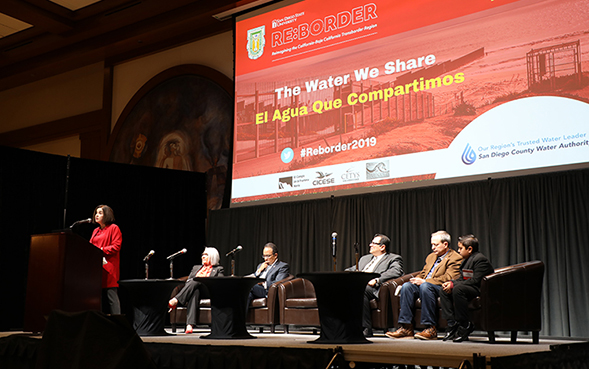Five Takeaways from Re:Border: The Water We Share
Shortages and pollution persist, but there are solutions just around the corner.

“Climate change is changing the math on water availability.”
From sewage spills to clean water, transborder water policy is an issue with a vital impact on millions of people.
“The Water We Share,” a two-day binational conference that concludes today, Nov. 26, in Tijuana, brings together researchers, public policy experts and community stakeholders. Through a variety of panel discussions, presentations and a showcase of student research, the Re:Border conference is exploring how San Diego State University and its regional partners can contribute to innovative solutions for water-related challenges in the transborder region.
“We’re very tied together with our water,” said Jim Madaffer, board chair of the San Diego County Water Authority, which co-sponsored the conference.
SDSU President Adela de la Torre said she hoped the conference, envisioned as the first in an annual meeting of minds on transborder and binational issues, will call attention to solutions, and regional approaches to common concerns.
The conference continues today at Universidad Autónoma de Baja California (UABC) with panels on climate change, water security, and risks; water and food; and water and equity.
Here are five key takeaways from Day 1 of the conference, held at the Conrad Prebys Aztec Student Union on the SDSU campus:
1) Wastewater recycling is the next big thing…
There’s a lot of enthusiasm for San Diego’s “Pure Water” wastewater recycling project. Similar to recycling already in use in Orange County, it is expected to provide more than one-third of the city’s water by 2035, reducing reliance on the Colorado River and aqueducts from Northern California and providing greater stability during droughts. In its first phase, expected to kick in about 2023, it is slated to provide 30 million gallons of clean water a day from treated sewage.
David Gibson, executive officer of the San Diego Regional Water Quality Control Board, said something similar could be done with transboundary flows at the border, diverting water from the Tijuana River. “We can treat that and discharge it offshore as we always have, but why not envision that water as a source?”
Purified at San Diego’s South Bay Water Reclamation Plant, he said, it could be transported to reservoirs on both sides of the border.
2) …and the next big thing after that could be stormwater capture.
“Climate change is changing the math on water availability,” Gibson said. As a major opportunity toward developing a sustainable local water supply, he said, “it’s going to pencil out” in as little as 10-15 years. “Now is the time to make those kinds of investments.”
Matt O’Malley, executive director of the advocacy, education and community engagement group San Diego Coastkeeper, said San Diego could get as much as 22% of its water from stormwater that currently is dumped into the Pacific Ocean and “turn a liability into an asset” that further promotes water independence.
3) Baja California is exploring wastewater recycling as well.
The state is exploring a project that could generate potable water for Tijuana, Tecate and Mexicali, said Leopoldo Mendoza Espinoza, of the Oceanology Research Institute. “One of the ideas,” he said, “is to provide good treatment to the wastewater of Tijuana and send it to Guadalupe Valley,” farmland in the region’s wine country.
4) Recycled sewage is clean, but…
The health implications of wastewater recycling have not been fully explored, said Rick Gersberg, professor of environmental health at SDSU’s School of Public Health. The product goes through multiple stages of purification including activated charcoal, reverse osmosis and exposure to ultraviolet light before being conveyed to reservoirs for the normal water treatment.
Gersberg said the treatment results in nondetectable levels of the viruses, parasites, organic substances and hundreds of other contaminants for which the water is tested. But there are hundreds if not thousands of other compounds that can break down and pass through the human body – including antibiotics and drugs – where little is known about their concentration (if any) in the treated water.
“Nothing comes with absolute guarantees these days,” said Gersberg, adding that additional research should include epidemiology studies on people drinking the water. “There are things we don’t know that we don’t know,” Gersberg said.
5) Momentum is building for projects to alleviate cross-border sewage spills from the Tijuana River Valley.
Mexico and the United States both are taking steps on the decades-long problem of sewage flows into the ocean from Tijuana’s overburdened treatment system. Conference participants were unanimous in their view that the problem can only be solved at the national level, not by the cities or even the states affected by the decades-old contamination, which pollutes coastal areas from Rosarito Beach to Coronado.
In opening remarks at the conference, San Diego Mayor Kevin Faulconer said “We have everybody’s attention. We are on the cusp of getting the funding that we need on both sides of the border that are going to make a significant difference.”
Carlos González Gutiérrez, consul general of Mexico in San Diego, said the nation “is strongly committed to ending the sewage problem” and that federal resources will be poured into the operation and maintenance of the Tijuana treatment system. “I am convinced that binational collaboration will bring a lasting solution to this environmental, political and economic issue,” González Gutiérrez said.
And U.S. Rep. Juan Vargas, who delivered the day’s closing remarks, said he has introduced legislation paving the way for U.S. contributions to the work that is needed through the North American Development Bank, a bilateral financial institution created under NAFTA in part to implement cross-border spending projects. Vargas said the bill has been approved in committee and is pending in the full House of Representatives.



